|
|
| Michelle's Earth Foundation Newsletter |
Summer 2010
| |
|
Michelle's
Earth Foundation, P.O. Box 5140 Preston King Station, Arlington, Virginia
22205
|
Dear Friend of MEF,
Please help friends of Michelle's Earth in New Orleans. The Jericho Road Episcopal Housing Initiative has allowed us to test for lead and plant sunflowers for phytoremediation on several of the lots it owns in historic Central City. One of the lots where we planted now safely grows a vegetable garden on S. Saratoga Street.
Now, we can help out Jericho Road by voting for them in a contest that's collaboration between the Fruit Tree Planting Foundation and Dreyer's Fruit Bars.
Go to Communities Take Root,Jericho Road Episcopal Housing Initiative  | look up Jericho Road Episcopal Housing Initiative in Louisiana and VOTE. You can vote EVERY DAY until the deadline on August 31.
Check out the video on youtube.
While many resources have been directed to construction and social services, the neighborhood still lacks green space, fresh food, and environmental education opportunities. A fruit tree orchard would fulfill these unmet needs and contribute to Jericho Road's holistic approach to neighborhood revitalization. The proposed property is located in a central and easily accessible part of the neighborhood. Currently, the large piece of land lies empty between three apartment complexes and an old auto repair shop; the lot often becomes a dumping ground for waste and thus an eyesore for those in the community. Yet, sunshine fills this piece of land throughout the day and numerous surrounding neighbors have a direct view of the property. Nearby residents are committed to this transformation, with the added benefit of teaching local children the growing process. The Saratoga Street Fruit Orchard would not only redevelop this property and bring access to fresh food, but also provide an opportunity for residents to collectively transform their neighborhood.
|
|
Sunflowers in New Orleans
Ian Willson and Tulane students plant sunflowers  | MEF's Sunflower Project in New Orleans is still going strong. Over spring 2010 Ian Wilson and MEF teamed up with Avram Penner of the Broadmoor Neighborhood Association and Tulane University students to plant blighted and toxin laden lots in and around Broadmoor. The students were taking a service learning class, Politics and Community, in which they partnered with non-profit organizations to gain basic organizing skills. They were very inquisitive and certainly learned a lot through their experiences. More than a couple of them volunteered to help MEF in the future!
Ian is still working with Professor Dr. Ed Bush and doctoral student Daniel Wells. They assist an ongoing study on practical applications for homeowners to use plants with phytoremediation qualities. They obtain soil samples from these lots to test for toxicity.
This summer planting will continue as Charlie Barnes, an Americorps volunteer organizer, canvases the Broadmoor neighborhood for blighted and potentially lead contaminated soil to clean by planting sunflowers. He has an army of volunteers ready to help clean up the neighborhood all summer long. We welcome Charlie and his volunteers.
|
Doug Varney's roses for Michelle in the Siberian spruce on the UVM Green  |
Doug's Flowers on the UVM Green |
MEF President Gail Fendley, H-B Award Recipient Mary Kallem, and Randy McKnight, MEF Board Member 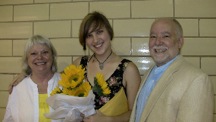 |
Michelle's Redbud Tree at the Saltzinger's Home 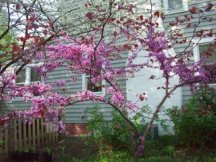 | |
|
Quiz
 Questions:
1: The World Cup teams of Brazil, Portugal and the Netherlands wore jerseys made of what material?
2: How many households in the United States are off-the-grid? 3: How fast does sound travel in water?
Answers: 1: recycled polyester and up to eight plastic bottles spun into
yarn per jersey. The uniforms were 15% lighter and kept players cooler
and drier by drawing sweat away from the body. 2: about 750,000 according to Nick Rosen, author of Off the Grid 3: four times faster than in air |
|
|
Spain's Solar Power Plant, Solucar
by Stephanie Lewis
Stephanie Lewis  | As I sit in Retiro Park, soaking in the sun's rays as late as 9 p.m., I
reflect upon how much I enjoy the strength of the Spanish sun year-round
in Madrid. Further south in Andalusia, the sun is even stronger-in
fact, temperatures soar so high during the summer that virtually no one
goes outside from 3 p.m. till sunset; even businesses alter their
timetables to enable employees to go home by mid-afternoon. It sounds
like a pretty ideal location to have one of the largest solar power
plants in the world, doesn't it?
Twenty miles west of Seville
stretches a scene that looks like something out of a sci-fi movie: 1,879
gigantic glass mirrors reflect light to two giant towers, the intensity
of which illuminates the water vapor and dust particles in the air,
creating a futuristic glow. These towers and mirrors are part of the
Solúcar solar power project, built by the Spanish company Abengoa. This
solar farm represents Spain's increasing focus on renewable energy,
though it already generates 3% of Spain's total power, the highest
percentage of any country. The United States, for example, generates
less than 1% of its energy from renewable resources.
Solucar 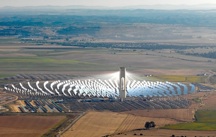 | The Solúcar
solar farm implements various solar technologies. The one represented
by its towers is one of the more innovative: concentrated solar power
(CSP). In thinking of solar power, most of us imagine the photovoltaic
process, in which solar panels absorb the sun and directly convert the
rays into electricity. In CSP, however, giant mirrors called heliostats
are used to condense, intensify and direct the sun's rays to one
specified point on a tower, creating intense heat that boils water
inside the tower. The resultant steam drives a turbine and generates
electricity-a process not unlike coal-driven turbines, but without the
greenhouse gas emissions.
Construction of the first tower in the
Solúcar project began in March 2007, whence it became the world's first
commercial concentrating solar power. The second, begun in May 2009, is
now the largest solar power tower in the world. Together, the two
concrete towers, one 50 stories high and the other 35, produce 31
megawatts of power. By the time Abengoa finishes building a third tower
and new installations, however, the company predicts a productive
capacity of 300 megawatts of energy, an amount sufficient to power
roughly 200,000 houses (or enough for the daytime needs of Seville). Correspondingly, the annual emission of 185,000 tons of CO2 will be
prevented.
The implications of using an energy source as
earth-friendly and renewable as the sun are exciting to say the least.
But this system has its flaws: first, the power produced by the sun
cannot be stored for nighttime use but rather must be transferred
immediately to where it will be consumed; and second, the production is
inconsistent: on a rainy or cloudy day, the sun takes the day off-and
the plant does as well.
Every energy plan has its downfalls. The
benefits of clean, renewable energy sources over fossil fuels, however,
far outweigh any disadvantages. And the efforts of countries like Spain
towards maximizing their use is of paramount importance, as these
sources naturally and continuously renew themselves by definition. By
increasing our use of natural, renewable sources of energy and
decreasing our dependence on fossil fuels, we will be taking a little
less from the earth and thereby contribute to a more sustainable and
productive future. ¡Que viva el sol de España!
|
Student Video Projects in Arlington and Cancun
Heather Spence
[(L-R Heather, Jade, Lupita (CONANP), Eduardo (Jade's Teacher at TecMilenio)] Jade receives congratulations for her winning video at TecMilenio High School, Cancun 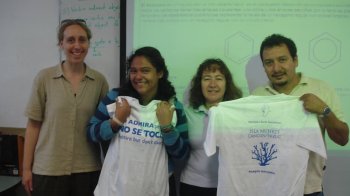 | Thank you to the teachers and students who participated in the latest round of video projects as part of the "Arlington and Cancun Students Connecting for Environmental Conservation" Program, made possible by Michelle's Earth Foundation and in partnership with the Mexican National Commission for Natural Protected Areas. Students volunteered to participate in this program, to create their own educational videos about the environment and share them with each other and the world. In Cancun, a video contest was held. The winner is Jade from TecMilenio High School, for her video "Acciones Sencillas" about "Simple Actions" you can take to help the environment. She received a Parque Nacional T-Shirt and a snorkeling trip to the coral reef. You can watch her video online. In Arlington, students from Bill Van Evera's class at HB Woodlawn watched Jade's video and then made their own on topics they were passionate about: rainforests, and global warming. You can also check out these videos online. The Mexican and US students have so much energy, it is contagious - and encouraging! Stay tuned for more students and schools connecting for environmental conservation. If you would like to learn more or get involved, please contact me. |
Shallow-water EAR Hydrophone 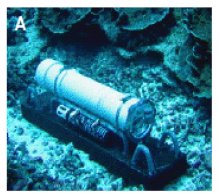 |
MEF is proud to announce a new bioacoustics' project in Yum Balam,
Mexico. Project leader Heather Spense will lead the effort to deploy a
hydrophone system on the ocean floor near the Mesoamerican Reef area of
Yum Balam. The hydrophone will collect all sounds of dolphins, fish,
shrimp, whale sharks and other marine creatures that live in and
migrate through this area. It is hoped that this project will the first
for a new Center
for Sustainability, encouraging further research and
conservation efforts. Given the unknown effects of the Gulf oil spill
it has become even more important to establish a base line for the
area's ecosystem to determine changes.
Good luck Heather as you set up the hydrophone in early September!
|
In this season of great abundance let us remember those less fortunate by
giving our garden surplus to local food banks.
|
|
|
|
|
|
|